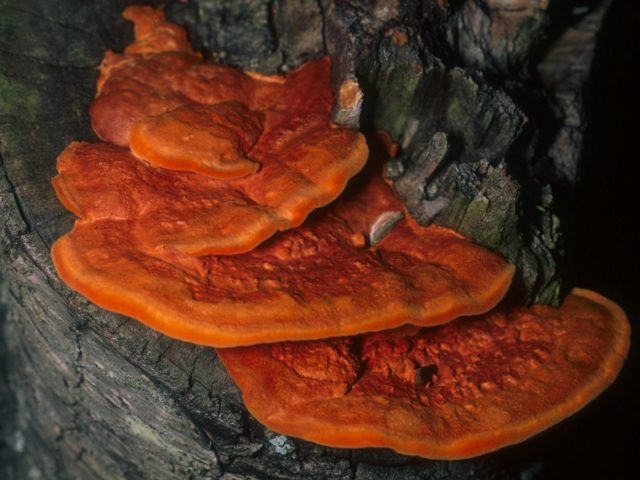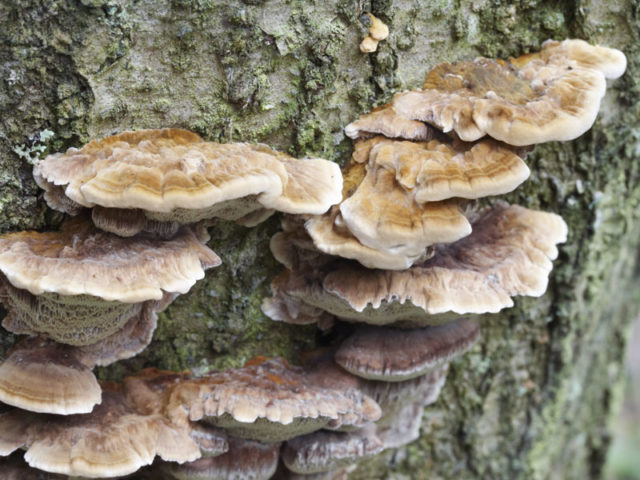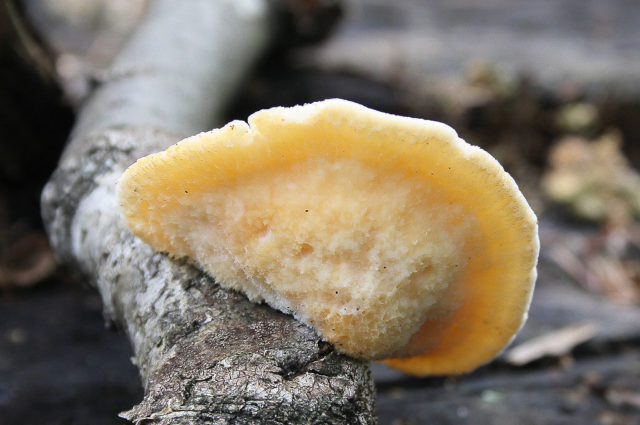Content
Pycnoporellus brilliant (Pycnoporellus fulgens) is a bright representative of the mushroom world. In order not to confuse it with other species, you need to know how it looks, where it grows and how it differs.
Description of pycnoporellus brilliant
Pycnoporellus brilliant is also known under a different name - shining tinder fungus. This is a species belonging to the basiomycetes from the Fomitopsis family.
The body of the fungus is a sessile or half-fan-shaped cap, which rarely grows strongly. Its dimensions range from 8 cm in length to 5 cm in width. The leg is pronounced (if any). The edges are drooping, uneven, sometimes torn. The color is dull, yellowish-white, later turning into orange and crimson. The surface is smooth and shiny, sometimes with a velvety bloom, closer to the base, bumpy and rough, with light or almost white borders of the cap.
The inner layer is fleshy, large-pored, sometimes dissected in old specimens. Over time, it is subject to destruction, decay and insect attack. The pores are filled with a pale gray powder, long, irregular in shape, often with split or ragged edges. Color from beige to pale orange, lightening towards the edges.
Fresh mushroom, when broken, exudes a pungent rare odor. The center is dense, fibrous, yellowish or creamy. When dry, the pulp becomes brittle and brittle.

Colonies of pycnoporellus lustrous often infect wood, which is already parasitized by other species of organisms.

Vibrant coloration makes the brilliant pycnoporellus stand out from the forest greenery
Where and how it grows
Shiny pycnoporellus grows mainly in spruce forests, mixed forests, on deadwood (pine, spruce, fir), less often on the trunks of dead deciduous trees (aspen, birch, oak). Loves high humidity, shade, parasitizes on dead colonies of other fungi.
In Russia, pycnoporellus brilliant is widespread in the Nizhny Novgorod region, appears from early summer, grows until late autumn. It is also found in the Leningrad region - to the north-west of St. Petersburg, but not very often.
Is the mushroom edible or not
Pycnoporellus brilliant has a mild taste. No food intake data documented. In medicine, an extract from the body of brilliant pycnoporellus is used to combat pathogenic bacteria of the genus Candida. There is unverified evidence that pycnoporellus brilliant, when consumed raw, has a weak inhibitory effect on the nervous system and causes hallucinations.
Doubles and their differences
It is easy to confuse pycnoporellus lustrous with similar types of mushrooms:
- The cinnabar red tinder tree has similar external data: a sedentary rounded fruiting body up to 2 cm thick and up to 12 cm in diameter. Young specimens are painted in bright carrot, red, orange shades. As it grows and ages, the color changes to ocher or brownish-carrot color. Cork pulp, velvety surface on young mushrooms, rough on old ones. It is an annual representative of the mushroom kingdom, but spores can persist for a long time in the ground or wood. Not edible.It differs from brilliant pycnoporellus in a brighter color, pore size and branching of the edges.
The vermilion cinnabar is a food source for many forest insects.
- Inonotus is radiant. One-year-old mushroom 3-8 cm long and 2 cm wide. It grows in the middle to tree trunks, forms colonies. The hat is fan-shaped, brownish-red, pale beige, brownish. The edges are torn, broken. The surface is wrinkled, knotty, striated, in some places protruding. The pulp is fibrous, cork structure, when milled it turns brown and releases a yellowish liquid. The mushroom is inedible. It differs from brilliant pycnoporellus in color, place and method of growth (rows or tiers).
Radiant inonotus grows freely on rotten or semi-dead trunks of alder, linden and even birch
- Tyrometses kmeta. The fruiting body is small, sessile, attached throughout the structure, thin. Up to 6 cm in diameter and up to 1 cm thick. The borders are dense, sometimes ciliated. The color in young specimens is almost white, it can be milky or creamy, with age it becomes orange or turns brown. The surface is rough, medium pubescent. The pulp is watery, soft. The pores are small, uneven. It grows only on dead deciduous wood - this is different from shining pycnoporellus. A rare species, inedible.
Tyromeces kmeta resembles a slice of lemon or other citrus, adherent to a tree
Conclusion
Pycnoporellus brilliant - an amazing representative of its family, but little studied and not suitable for human consumption. It has several twins, differing in the place of growth and in some external features.
https://www.youtube.com/watch?v=zA6ZZ8VZRbI











